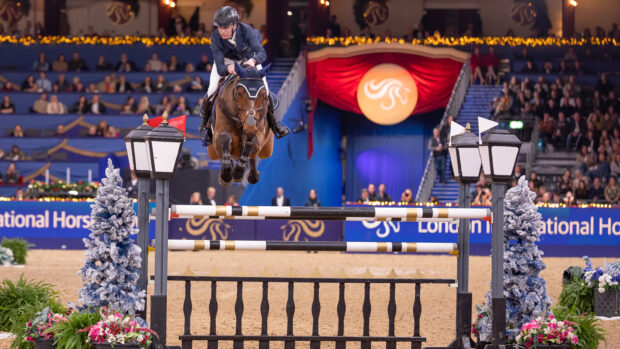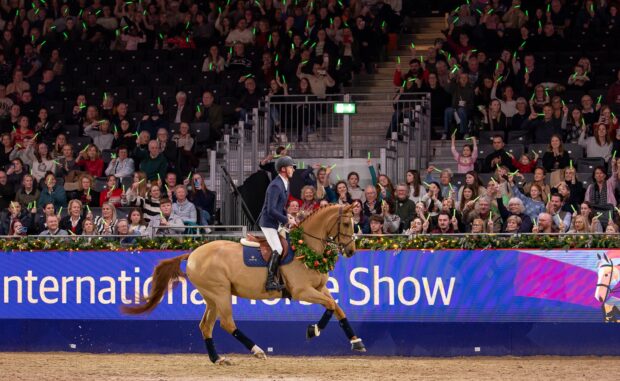In this exclusive article for H&H subscribers, equestrian journalist Pippa Cuckson attempts to unravel the disciplinary procedures that apply to horse abuse in equestrian sport and answer some of the most common questions that fans ask
Why was Charlotte Dujardin promptly suspended for the lunge-whipping video when other riders under investigation for horse abuse continue to compete? Why do some riders merely receive a yellow warning card when others are banned for years? Why does the international equestrian federation (FEI) appear to do nothing when people send in complaints? These questions appear on social media – and in journalists’ mailboxes – with increasing frequency as the challenge to equestrianism’s social licence grows.
The handling of horse abuse by equestrian regulatory bodies is complex; even media who follow the tribunal system closely find it baffling. In this article we attempt to unravel the disciplinary procedures that apply to horse abuse in sport.
FEI General Regulations (GRs) apply to all FEI-regulated sports. Each has bespoke rules but must follow GR Article 142, which defines horse abuse as “an action or omission which causes or is likely to cause pain or unnecessary discomfort to a Horse.
{"content":"PHA+4oCcVGhpcyBpbmNsdWRlcywgYnV0IGlzIG5vdCBsaW1pdGVkIHRvIGFueSBvZiB0aGUgZm9sbG93aW5nOiBUbyB3aGlwIG9yIGJlYXQgYSBIb3JzZSBleGNlc3NpdmVseTsgVG8gc3ViamVjdCBhIEhvcnNlIHRvIGFueSBraW5kIG9mIGVsZWN0cmljIHNob2NrIGRldmljZTsgVG8gdXNlIHNwdXJzIGV4Y2Vzc2l2ZWx5IG9yIHBlcnNpc3RlbnRseTsgVG8gamFiIHRoZSBIb3JzZSBpbiB0aGUgbW91dGggd2l0aCB0aGUgYml0IG9yIGFueSBvdGhlciBkZXZpY2U7IFRvIGNvbXBldGUgdXNpbmcgYW4gZXhoYXVzdGVkLCBsYW1lIG9yIGluanVyZWQgSG9yc2U7IFRvIHJhcCBhIEhvcnNlOyBUbyBhYm5vcm1hbGx5IHNlbnNpdGlzZSBvciBkZXNlbnNpdGlzZSBhbnkgcGFydCBvZiBhIEhvcnNlOyBUbyBsZWF2ZSBhIEhvcnNlIHdpdGhvdXQgYWRlcXVhdGUgZm9vZCwgZHJpbmsgb3IgZXhlcmNpc2U7IFRvIHVzZSBhbnkgZGV2aWNlIG9yIGVxdWlwbWVudCB3aGljaCBjYXVzZXMgZXhjZXNzaXZlIHBhaW4gdG8gdGhlIEhvcnNlIHVwb24ga25vY2tpbmcgZG93biBhbiBvYnN0YWNsZS7igJ08L3A+CjxoMj5UaGUgYWJzZW5jZSBvZiBoeXBlcmZsZXhpb248L2gyPgo8cD5Sb2xsa8O8ciwgYWthIGh5cGVyZmxleGlvbiwgKHRvIGJlIGRpc2N1c3NlZCBpbiBhIGZ1dHVyZSBIJmFtcDtIIHN1YnNjcmliZXIgZmVhdHVyZSksIGlzIG5vdCBtZW50aW9uZWQgaW4gQXJ0aWNsZSAxNDIsIGFuZCBzbyBmYXIgaXMgdW5zYW5jdGlvbmVkIGluIEZFSSBkcmVzc2FnZSwgZGVzcGl0ZSBiZWluZyBhIGJhbm5lZCB0ZWNobmlxdWUgYW5kIG9uZSBvZiB0aGUgc3BvcnTigJlzIGhvdHRlc3QgdG9waWNzLjwvcD4KPHA+PHNlY3Rpb24gaWQ9ImVtYmVkX2NvZGUtMzEiIGNsYXNzPSJoaWRkZW4tbWQgaGlkZGVuLWxnIHMtY29udGFpbmVyIHN0aWNreS1hbmNob3IgaGlkZS13aWRnZXQtdGl0bGUgd2lkZ2V0X2VtYmVkX2NvZGUgcHJlbWl1bV9pbmxpbmVfMiI+PHNlY3Rpb24gY2xhc3M9InMtY29udGFpbmVyIGxpc3RpbmctLXNpbmdsZSBsaXN0aW5nLS1zaW5nbGUtc2hhcmV0aHJvdWdoIGltYWdlLWFzcGVjdC1sYW5kc2NhcGUgZGVmYXVsdCBzaGFyZXRocm91Z2gtYWQgc2hhcmV0aHJvdWdoLWFkLWhpZGRlbiI+DQogIDxkaXYgY2xhc3M9InMtY29udGFpbmVyX19pbm5lciI+DQogICAgPHVsPg0KICAgICAgPGxpIGlkPSJuYXRpdmUtY29udGVudC1tb2JpbGUiIGNsYXNzPSJsaXN0aW5nLWl0ZW0iPg0KICAgICAgPC9saT4NCiAgICA8L3VsPg0KICA8L2Rpdj4NCjwvc2VjdGlvbj48L3NlY3Rpb24+PC9wPgo8cD5ZZWxsb3cgY2FyZHMgZm9yIGh5cGVyZmxleGlvbiBoYXZlIGJlZW4gaGFuZGVkIGRvd24gdHdpY2UgaW4gdHdvIG1vbnRocyBpbiBldmVudGluZyBkcmVzc2FnZSB3YXJtLXVwcywgaW5jbHVkaW5nIGF0IHRoZSBQYXJpcyBPbHltcGljIEdhbWVzIHdoZXJlIHRoZSBGRUkgc2FpZCBCcml0aXNoLWJhc2VkIEJyYXppbGlhbiBDYXJsb3MgUGFycm8gY2F1c2VkIGhpcyBob3JzZSAmIzgyMjA7dW5uZWNlc3NhcnkgZGlzY29tZm9ydC4mIzgyMjE7PC9wPgo8cD5Eb2VzICYjODIyMDt1bm5lY2Vzc2FyeSBkaXNjb21mb3J0JiM4MjIxOyBpbXBseSB0aGF0IHNvbWUgZGlzY29tZm9ydCBpcyAmIzgyMjA7bmVjZXNzYXJ5JiM4MjIxOz8gQSBGRUkgc3Bva2VzcGVyc29uIHNhaWQgQXJ0aWNsZSAxNDIgbWF5IGJlIHJlLXdvcmRlZCBuZXh0IHllYXIuIEl0IGlzIGFsc28gd29ydGggbm90aW5nIHRoYXQgdGhlIEZFSSBUcmlidW5hbCBoYXMgcHJldmlvdXNseSBkZWNpZGVkIHRoYXQgcGFpbiBuZWVkIG5vdCBiZSBwcm92ZWQgaW4gb3JkZXIgZm9yIGFidXNlIHRvIGhhdmUgb2NjdXJlZC48L3A+CjxoMj5Ib3cgaW50ZXJuYXRpb25hbCByaWRlcnMgY2FuIGJlIHBlbmFsaXNlZDwvaDI+CjxwPlRoZSBGRUkgZW5jb3VyYWdlcyBuYXRpb25hbCBmZWRlcmF0aW9ucyB0byBoYW5kbGUgdGhlaXIgb3duIHJpZGVyc+KAmSBhYnVzZSBjYXNlcyB3aGVyZSB0aGV5IGhhdmUgYWRlcXVhdGUgcG93ZXJzLCBlc3BlY2lhbGx5IHdoZW4gbGFuZ3VhZ2UgaXMgYW4gaXNzdWUuIEFueSByZXN1bHRpbmcgcmlkZXIgc3VzcGVuc2lvbiBpcyBtaXJyb3JlZCBieSB0aGUgRkVJLjwvcD4KCjxwPlRoZXJlIGFyZSB0aHJlZSBtYWluIHdheXMgdGhhdCBhYnVzZSBpcyBwZW5hbGlzZWQgaW4gRkVJIHNwb3J0LjwvcD4KPHA+QXQgYSBjb21wZXRpdGlvbiDigJMgdXN1YWxseSByZWZlcnJlZCB0byBpbiBsZWdhbCBkb2N1bWVudHMgYXMgdGhlICYjODIyMDtmaWVsZCBvZiBwbGF5JiM4MjIxOyDigJMgdGhlIGdyb3VuZCBqdXJ5IGFuZCBvdGhlciBvZmZpY2lhbHMgY2FuIGdpdmUgYSB5ZWxsb3cgd2FybmluZyBjYXJkIGFzIGEgbWluaW11bSwgbW9zdCBjb21tb25seSBkdWUgdG8gZXhjZXNzaXZlIHVzZSBvZiB0aGUgd2hpcCBvciBzcHVycyBpbiB0aGUganVtcGluZyBkaXNjaXBsaW5lcy4gSW4gRkVJIGVuZHVyYW5jZSwgYSB5ZWxsb3cgY2FyZCBmb3IgYWJ1c2UgaXMgY291cGxlZCB3aXRoIGF1dG9tYXRpYyBkaXNxdWFsaWZpY2F0aW9uLiBJbiBhbGwgb3RoZXIgZGlzY2lwbGluZXMsIGEgeWVsbG93LWNhcmRlZCByaWRlciBtYXkgcmVtYWluIGluIHRoZSBjb21wZXRpdGlvbi4gVHdvIHllbGxvdyBjYXJkcyBmb3IgYW55IHJlYXNvbiBpbiAxMiBtb250aHMgdHJpZ2dlciBhbiBhdXRvbWF0aWMgdHdvLW1vbnRoIHN1c3BlbnNpb24uPC9wPgoKPHA+QSB5ZWxsb3cgY2FyZCBjYW5ub3QgYmUgcmVmdXNlZCBiZWNhdXNlIHRoZSBqdWRnZXMmIzgyMTc7IGRlY2lzaW9uIGlzIGZpbmFsLCBldmVuIGlmIGxhdGVyIGZvdW5kIHRvIGJlIHdyb25nLiBUaGUgaW52aW9sYWJpbGl0eSBvZiB0aGUgZ3JvdW5kIGp1cnkgaXMgYSBrZXkgcHJpbmNpcGxlIG9mIHNwb3J0IGxhdywgdXBoZWxkIG1hbnkgdGltZXMgYnkgdGhlIENvdXJ0IG9mIEFyYml0cmF0aW9uIGZvciBTcG9ydCAoQ0FTKSDigJMgdGhlIGNvdXJ0IG9mIGxhc3QgcmVzb3J0LjwvcD4KPGgyPkhvdyB5ZWxsb3cgY2FyZHMgYXJlIHVzZWQgaW4gZGlmZmVyZW50IGhvcnNlIHNwb3J0czwvaDI+CjxwPkZFSSBzcG9ydHMgaGF2ZSB2YXJ5aW5nIGFwcHJvYWNoZXMgdG8gd2FybmluZyBjYXJkcywgd2hpY2ggY2FuIGFkZCB0byB0aGUgY29uZnVzaW9uLjwvcD4KCjxwPkV2ZW50aW5nLCBmb3IgaW5zdGFuY2UsIHJlZ2FyZHMgc29tZSBidXQgbm90IGFsbCBpbnN0YW5jZXMgb2YgYmxvb2QgYXMgYWJ1c2UgYW5kIHdpbGwgZ2l2ZSByaWRlcnMgeWVsbG93IGNhcmRzIGFjY29yZGluZ2x5LiBJdCBoYW5kcyBkb3duIG1vcmUgPGEgaHJlZj0iaHR0cHM6Ly9kYXRhLmZlaS5vcmcvVG9vbHMvQmFzZURhdGEuYXNweD90YWJsZT1XYXJuaW5nQ2FyZHMvLy8vZXZlbnRpbmcvIj55ZWxsb3cgY2FyZHMgYW5kIHRoZSBsb3dlciBjYXRlZ29yeSByZWNvcmRlZCB3YXJuaW5nczwvYT4gdGhhbiBhbGwgb3RoZXIgRkVJIHNwb3J0cyBjb21iaW5lZCDigJMgcGFydGx5IHRvIGFkZHJlc3MgaW5jaWRlbnRzIHN1Y2ggYXMg4oCcZGFuZ2Vyb3VzIHJpZGluZ+KAnSwgd2hpY2ggaXMgbm90IHBlbmFsaXNlZCB0aHJvdWdoIHRoZSBzY29yaW5nIHN5c3RlbS4gSW4gc2ltcGxlIHRlcm1zLCB0aGUgbGVuZ3RoaWVyIGF0aGxldGljIGVmZm9ydCBvZiBldmVudGluZyBhbmQgcGVybWlzc2lvbiB0byBjYXJyeSB3aGlwcyBjcmVhdGVzIG1vcmUgb3Bwb3J0dW5pdGllcyBmb3IgaW5jaWRlbnRzIHRvIGVzY2FsYXRlIGludG8gYWJ1c2UuIEV2ZW50aW5nIGFsc28gaGFzIGEgYmVzcG9rZSwgYXV0b21hdGljIHR3by1tb250aCBiYW4gZm9yIGFueSByaWRlciByZWNlaXZpbmcgdGhyZWUgd2FybmluZ3MgaW4gMjQgbW9udGhzLjwvcD4KPHA+RHJlc3NhZ2UsIGF0IHRoZSBvdGhlciBleHRyZW1lLCBoYXMgaXNzdWVkIDxhIGhyZWY9Imh0dHBzOi8vZGF0YS5mZWkub3JnL1Rvb2xzL0Jhc2VEYXRhLmFzcHg\/dGFibGU9V2FybmluZ0NhcmRzLy8vL2RyZXNzYWdlLyI+b25seSBzaXggeWVsbG93IGNhcmRzIGluIDEyIG1vbnRoczwvYT4g4oCTIHR3byBmb3Igbm9uLXNwZWNpZmllZCBhYnVzZS4gQnV0IHVubGlrZSBldmVudGluZyBhbmQganVtcGluZywgZHJlc3NhZ2UgZG9lcyBub3QgbGlzdCBpdHMgb3RoZXIgd2FybmVkIHJpZGVycyBvbiBhIHB1YmxpYyBwbGF0Zm9ybS4gRkVJIGNoaWVmIHZldCBHb3JhbiBBa2Vyc3Ryb20gaGFzIGluZm9ybWFsbHkgY29uZmlybWVkIHRoYXQgc2V2ZXJhbCB3ZXJlIHdhcm5lZCBvdmVyIOKAnGJsdWUgdG9uZ3Vlc+KAnSBhdCBQYXJpcywgYnV0IHRoZXkgcmVtYWluIHVuLW5hbWVkLjwvcD4KPHA+VGhlcmUgaXMgbm8gaGludCB0aGF0IGEgb25lLXNpemUtZml0cy1hbGwgcG9saWN5IHdpbGwgYmUgaW50cm9kdWNlZCBhbnkgdGltZSBzb29uLjwvcD4KPGgyPldoZW4gc3Ryb25nZXIgcHVuaXNobWVudCBpcyBkZWVtZWQgbmVjZXNzYXJ5PC9oMj4KPHA+VGhlIHNlY29uZCBtZXRob2Qgb2YgcGVuYWxpc2luZyByaWRlcnMgaXMgdGhlIDxhIGhyZWY9Imh0dHBzOi8vaW5zaWRlLmZlaS5vcmcvc3lzdGVtL2ZpbGVzL05ldyUyMENhc2UlMjBzdGF0dXMlMjB0YWJsZSUyMC0lMjBBRFAlMjBwcm9jZWVkaW5ncyUyMDA0JTIwMDklMjAyNCUyMC0lMjAlMjBGaW5hbC5wZGYiPkFkbWluaXN0cmF0aXZlIERpc2NpcGxpbmFyeSBQcm9jZWR1cmUgKEFEUCk8L2E+LCBtb3N0bHkgdXNlZCB3aGVuIGEgRkVJIGdyb3VuZCBqdXJ5IHRoaW5rIGEgc3Ryb25nZXIgcHVuaXNobWVudCBpcyByZXF1aXJlZC4gVGhlIEFEUCBpcyBhIHR5cGUgb2YgZml4ZWQtcGVuYWx0eSwgaGFuZGxlZCBieSB0aGUgRkVJIGxlZ2FsIGRlcGFydG1lbnQgaW4gTGF1c2FubmUsIFN3aXR6ZXJsYW5kLCB3aXRoIGZpbmVzIHVwIHRvIDIsMDAwIFN3aXNzIGZyYW5jcyBhbmQvb3IgYSBzdXNwZW5zaW9uIG9mIHRocmVlIG1vbnRocy4gVGhpcyBwYXN0IHllYXIgdGhlcmUgaGF2ZSBiZWVuIGVpZ2h0IEFEUCBhYnVzZSBjYXNlcyDigJMgYWxsIGZyb20gc2hvdyBqdW1waW5nIGFuZCBlbmR1cmFuY2UsIHdoaWNoIHRoZSBGRUkgYXR0cmlidXRlcyB0byB0aG9zZSBzcG9ydHMgaGF2aW5nIHRoZSBtb3N0IHBhcnRpY2lwYW50cy48L3A+CjxwPkluIGFudGktZG9waW5nIGNhc2VzLCB0aGUgRkVJIGlzIG1ha2luZyBpbmNyZWFzaW5nIHVzZSBvZiB0aGUg4oCcQ29uc2VudCBBd2FyZOKAnSwgYSBwbGVhLWJhcmdhaW4gc3lzdGVtIG9mZmVyaW5nIGEgcmVkdWNlZCBzdXNwZW5zaW9uIGZvciBwcm9tcHQgYWRtaXNzaW9uLiBUaGlzIGhhcyB5ZXQgdG8gYmUgdXRpbGlzZWQgZm9yIGhvcnNlIGFidXNlLjwvcD4KPGgyPldoaWNoIGNhc2VzIGdvIHRvIGEgdHJpYnVuYWw\/PC9oMj4KPHA+VGhlIHRoaXJkIHRyaWVkIGFuZCB0ZXN0ZWQgbWV0aG9kIGlzIGZvciB0aGUgbW9zdCBlZ3JlZ2lvdXMgYWJ1c2UsIG9yIHdoZW4gdGhlIHJpZGVyIHdpc2hlcyB0byBiZSBoZWFyZCDigJMgcmVmZXJyYWwgdG8gdGhlIEZFSSYjODIxNztzIGluZGVwZW5kZW50IHRyaWJ1bmFsLjwvcD4KPHA+VGhlIHRyaWJ1bmFsIGlzIGFuIGVsZWN0ZWQgcGFuZWwgb2YgZXF1ZXN0cmlhbnMgd2l0aCBkaXN0aW5ndWlzaGVkIGxlZ2FsIGJhY2tncm91bmRzLiBQYXN0IGFuZCBwcmVzZW50IG1lbWJlcnMgaGF2ZSBpbmNsdWRlZCBDaHJpc3RvcGhlciBIb2Rzb24gS0MsIGZvcm1lciBGRUkgdmljZSBwcmVzaWRlbnQgYW5kIEp1ZGdlIEFkdm9jYXRlIEdlbmVyYWwgb2YgdGhlIE5ldyBaZWFsYW5kIEFybWVkIEZvcmNlczsgYW5kIHRoZSBkcmVzc2FnZSBqdWRnZSBDZXNhciBUb3JyZW50ZSwgYSB2ZXRlcmFuIGFyYml0cmF0aW9uIGxhd3llciBpbiBDb2xvbWJpYS48L3A+CjxwPkluIHRoZSBwYXN0IHR3byBkZWNhZGVzLCB0cmlidW5hbCBoYXMgaGFuZGxlZCAyMCBzZXJpb3VzIGhvcnNlIGFidXNlIGNhc2VzLiBTb21ldGltZXMgaXQgZGVjaWRlcyB2aWEgZXh0ZW5zaXZlIHdyaXR0ZW4gcmVwcmVzZW50YXRpb25zLiBXaGVuIGEgcmlkZXIgcmVxdWVzdHMgYW4gaW4tcGVyc29uIGhlYXJpbmcsIGl0IGlzIGNvbmR1Y3RlZCBsaWtlIGEgdHJpYWwuPC9wPgo8cD5CdXQgdGhlIHRyaWJ1bmFsIGlzIHdoZXJlIHRoaW5ncyBnZXQgdGltZS1jb25zdW1pbmcuIFdoaWxlIGEgZ3JvdW5kIGp1cnkgY2FuIHllbGxvdy1jYXJkIGEgcmlkZXIgb24gdGhlIHNwb3QsIGF0IHRoZSB0cmlidW5hbCB0aGUgcHJvY2VzcyB0dXJucyBvbiBpdHMgaGVhZCBhbmQgdGhlIOKAnGJ1cmRlbiBvZiBwcm9vZuKAnSBmYWxscyBvbiB0aGUgYWNjdXNlci48L3A+CjxoMj5XaGF0IGhhcHBlbnMgYXQgdHJpYnVuYWw\/PC9oMj4KPHA+V2hlbiB0aGUgRkVJIGxlZ2FsIGRlcGFydG1lbnQgcHJvc2VjdXRlcyBhdCB0cmlidW5hbCwgaXQgbXVzdCBmaXJzdCBjb25kdWN0IGFuIGludmVzdGlnYXRpb24g4oCTIGxpbWl0ZWQgaW4gc2NvcGUsIGJlY2F1c2UgdGhlIEZFSSBpcyBub3QgdGhlIHBvbGljZS48L3A+CjxwPkEgc3Bva2VzcGVyc29uIGV4cGxhaW5lZDog4oCcSG9yc2UgYWJ1c2UgY2FzZXMgdGVuZCB0byBiZSByYXRoZXIgY29tcGxleCBhbmQgdXN1YWxseSBpbnZvbHZlIHRoZSBGRUkgaW4gdW5kZXJ0YWtpbmcgYW4gaW5pdGlhbCBpbnZlc3RpZ2F0aW9uLiBJbiB0aGUgYWJzZW5jZSBvZiBjbGVhciB2aWRlby9waG90b2dyYXBoaWMgZXZpZGVuY2UgdGhhdCBjb25maXJtcyBhYnNvbHV0ZWx5IHRoZSBhYnVzZSwgd2l0bmVzcyBldmlkZW5jZSBpcyBpbXBvcnRhbnQuIENvbnRhY3Rpbmcgd2l0bmVzc2VzLCBzZWN1cmluZyB0aGVpciBhZ3JlZW1lbnQgdG8gY29tZSBmb3J3YXJkIGFuZCBvYnRhaW5pbmcgd2l0bmVzcyBzdGF0ZW1lbnRzIGNhbiBiZSBhIGxlbmd0aHkgcHJvY2VzcyBmb3IgYm90aCB0aGUgRkVJIGFuZCB0aGUgZGVmZW5kYW50LuKAnTwvcD4KPHA+VGhlIHJpZGVy4oCZcyBsYXd5ZXJzIGNhbiBhbHNvIGVtcGxveSBkZWxheWluZyB0YWN0aWNzIOKAkyBhbHRob3VnaCB0aGUgRkVJIHNhaWQgaXQgd2FzIG5vdCBpbiBpdHMgaW50ZXJlc3RzIHRvIGdpdmUgZXhhbXBsZXMuPC9wPgo8cD5UaGlzIOKAnGJ1cmRlbiBvZiBwcm9vZuKAnSBhbHNvIGZhbGxzIG9uIG1lbWJlcnMgb2YgdGhlIHB1YmxpYyB3aG8gcHJvdGVzdCBhYnVzZSB0byB0aGUgRkVJLiBFdmVuIGlmIGEg4oCcd2hpc3RsZWJsb3dlcuKAnSBkb2VzIG5vdCBmZWFyIHJlcHJpc2FscywgdGhlIHBhcGVyd29yayBhbmQgZXZpZGVuY2UtZ2F0aGVyaW5nIGludm9sdmVkIGNhbiBiZSBhIGRldGVycmVudC4gSSBoYXZlIHVuZGVydGFrZW4gYSBmZXcgcGFzdCBwcm90ZXN0cyBteXNlbGY7IHdoaWxlIHRoZSBGRUkgbGVnYWwgZGVwYXJ0bWVudCBnaXZlcyBzdXBwb3J0LCBpdCBpcyBhIGJpZyDigJxhc2vigJ0gdG8gcHJlcGFyZSBldmlkZW5jZSBhbmQgZXZlbiBjcm9zcy1leGFtaW5lIGEgbGF3eWVyZWQtdXAgcmlkZXIgd2hlbiB5b3UgaGF2ZSBubyBsZWdhbCB0cmFpbmluZy48L3A+CjxwPk5vdCBzdXJwcmlzaW5nbHksIG9ubHkgaGFsZiBhIGRvemVuIGluZGl2aWR1YWxzIGhhdmUgYXR0ZW1wdGVkIHRoaXMgaW4gdGhlIHBhc3QgZGVjYWRlLCB0aG91Z2ggYWxsIOKAnHdvbuKAnSwgd2l0aCB0aGUgYWNjdXNlZCByaWRlcnMgc3VzcGVuZGVkIGZvciB1cCB0byB0d28tYW5kLWEtaGFsZiB5ZWFycy48L3A+CjxoMj5XaHkgc28gZmV3IGNhc2VzIGdvIHRvIHRyaWJ1bmFsPC9oMj4KPHA+VGhvdWdoIHZpZGVvIGNsaXBzIG9mIGFsbGVnZWQgYWJ1c2UgYXJlIHNoYXJlZCBvbmxpbmUgZnJlcXVlbnRseSwgYm90aCB0aGUgRkVJIGFuZCB0aGUgQnJpdGlzaCBFcXVlc3RyaWFuIEZlZGVyYXRpb24gKEJFRikgcmVjZWl2ZSBjb25zaWRlcmFibHkgZmV3ZXIgY29tcGxhaW50cyB0aGFuIHRob3NlIG9uIHNvY2lhbCBtZWRpYSBwbGF0Zm9ybXMgdGVuZCB0byBhc3N1bWUuIEEgQkVGIHNwb2tlc3BlcnNvbiBzYWlkIHByb2dyZXNzIGNhbiBiZSBoYW5kaWNhcHBlZCBieSDigJxpbnN1ZmZpY2llbnQgZXZpZGVuY2UsIG5vIGNsZWFyIHZpZGVvL3Bob3RvZ3JhcGhzLCBpbnN1ZmZpY2llbnQgd2l0bmVzcyBzdGF0ZW1lbnRzIGFuZCBpbmFiaWxpdHkgdG8gYnVpbGQgYSBzdHJvbmcgY2FzZSBhcyBhIHJlc3VsdCwgYW5kIGNvbXBsYWluYW50cyB1bndpbGxpbmcgdG8gZ28g4oCYb24gdGhlIHJlY29yZC7igJk8L3A+CjxwPuKAnFNvbWV0aW1lcyBpdOKAmXMgZG93biB0byB0aGUgcmVhY2ggb2Ygb3VyIG1lbWJlciBib2RpZXPigJkganVyaXNkaWN0aW9uLiBXZSBoYXZlIGxpbWl0ZWQgaW52ZXN0aWdhdGl2ZSBwb3dlcnMgb3V0c2lkZSBvZiBjb21wZXRpdGlvbiwgYW5kIGV2ZW4gbW9yZSBzbyB3aGVyZSB0aGUgcGFydGllcyBhcmUgbm90IG1lbWJlcnMgb2YgYW55IG1lbWJlciBib2R5LuKAnTwvcD4KPHA+SXQgY291bGQgYWxzbyBiZSBzYWlkIHRoYXQgdGhlIEZFSSBpcyBub3QgZ3JlYXQgYXQgY29tbXVuaWNhdGluZyB3aXRoIHByb3Rlc3RvcnMuIFRoZSBwcm9taW5lbnQgYW50aS1oeXBlcmZsZXhpb24gY2FtcGFpZ25lciBEciBFdmEgdmFuIEF2ZXJtYWV0IHN1Ym1pdHRlZCBzZXZlcmFsIHByb3Rlc3RzIHRvIHRoZSBGRUkgZm9yIGFsbGVnZWQgYWJ1c2UgZHVyaW5nIHRoZSBQYXJpcyBPbHltcGljcywgYnV0IHJlY2VpdmVkIG5vIGFja25vd2xlZGdlbWVudCBmb3IgYSBtb250aCDigJMgYW5kIHRoZW4gb25seSBhZnRlciBTd2VkaXNoIG5ld3NwYXBlciBJZHJhZXRzbW9uaXRvciBpbnRlcnZlbmVkLiA8ZW0+SCZhbXA7SDwvZW0+IGlzIGFsc28gaW4gdG91Y2ggd2l0aCB0aGUga2V5IHdpdG5lc3MgaW4gYW5vdGhlciBjYXNlIHVuZGVyIGxvbmctdGVybSBGRUkgaW52ZXN0aWdhdGlvbiDigJMgc2hlIGhhcyBub3QgaGVhcmQgZnJvbSB0aGUgRkVJIHNpbmNlIEp1bHkuPC9wPgo8cD5QYXVsaW5lIHZhbiBEcnVtcHQgb2YgQ2xlYW4gRW5kdXJhbmNlIGlzIHRoZSBvbmx5IG5vbi1sYXd5ZXIgdG8gaGF2ZSBkZWZlbmRlZCBhIHJpZGVy4oCZcyBhcHBlYWwgYWdhaW5zdCBzdXNwZW5zaW9uIGZvciBob3JzZSBhYnVzZSBhdCBDQVMuIFNoZSB0aGlua3MgdGhlIEZFSSBjb3VsZCBkbyBtb3JlIHRvIGVuY291cmFnZSBhbmQgYXNzaXN0IGNvbXBsYWluYW50cy4gU2hlIG5vdGVkIG9uZSBzb2xpZCBjYXNlIGZyb20gYW4gZW5kdXJhbmNlIHJhY2UgaW4gRnJhbmNlIHRoYXQgd2FzIGRpc3JlZ2FyZGVkIGJlY2F1c2UgdGhlIHByb3Rlc3RvcuKAmXMgaW5pdGlhbCBwcmVzZW50YXRpb24gd2FzIGluc3VmZmljaWVudC48L3A+CjxwPuKAnElmIHRoZSBGRUkgY2FtZSB1cCB3aXRoIGV2ZW4gYSBvbmUtcGFnZSBpbnN0cnVjdGlvbiBtYW51YWwgZm9yIHN1Ym1pdHRpbmcgYW4gYWJ1c2UgcHJvdGVzdCwgcGVvcGxlIHdvdWxkIGhhdmUgc29tZSBmcmFtZXdvcmsgdG8gd29yayB3aXRoIOKAkyBpdCBjb3VsZCBpbmNsdWRlIGNvbmZpcm1hdGlvbiBvZiB0aGUgcmlkZXLigJlzIGlkZW50aXR5LCBbY29tcGV0aXRvcl0gbnVtYmVycywgcGhvdG9ncmFwaHMsIGEgY2xlYXIgZGVzY3JpcHRpb24gb2Ygd2hhdCBoYXBwZW5lZCBhbmQgbmFtZXMgYW5kIGNvbnRhY3QgZGV0YWlscyBvZiBhbnkgd2l0bmVzc2VzLjwvcD4KPHA+4oCcRm9yIHRoZSBhdmVyYWdlIHBlcnNvbiwgZXZlbiBpZiB0aGV5IGtub3cgdGhlIHJ1bGVzLCBpdCYjODIxNztzIHZlcnkgZGlmZmljdWx0IHRvIHdyaXRlIGEgcHJvcGVyIGFidXNlIHByb3Rlc3QuIElkZWFsbHksIHBlb3BsZSBjb3VsZCBjb250YWN0IHRoZSBsZWdhbCBkZXBhcnRtZW50IHdpdGggcGljdHVyZXMgYW5kIHdpdG5lc3Mgc3RhdGVtZW50cyBhbmQgdGhlIEZFSSB3b3VsZCB3cml0ZSBpdCB1cCBmb3IgdGhlbS4gSG9yc2UgYWJ1c2Ugd2lsbCBiZSBhIGJpZ2dlciBwYXJ0IG9mIEZFSSBhY3Rpdml0eSDigJMgaXTigJlzIHRpbWUgZm9yIHRoZW0gdG8gc3RlcCB1cC7igJ08L3A+CjxoMj5XaGljaCBnb3Zlcm5pbmcgYm9kaWVzIGNhbiBzYW5jdGlvbiB3aGF0IGFuZCB3aGVyZT88L2gyPgo8cD5BYnVzZSBpcyB0aGUgb25lIHRoaW5nIHRoZSBGRUkgY2FuIHNhbmN0aW9uIG91dCBvZiBjb21wZXRpdGlvbiDigJMgaWYgdGhlIGFjY3VzZWQgd2FzIHJlZ2lzdGVyZWQgd2l0aCB0aGUgRkVJIG9yIGEgbWVtYmVyIG5hdGlvbmFsIGZlZGVyYXRpb24gYXQgdGhlIHRpbWUuIEFuIGFsbGVnYXRpb24gYWdhaW5zdCBhbiBPbHltcGlhbiB3YXMgb25jZSBkaXNtaXNzZWQgYmVjYXVzZSBoZSBoYWQgcmVjZW50bHkgcmV0aXJlZCBmcm9tIGNvbXBldGluZyBhbmQsIHdoaWxlIHN0aWxsIHdvcmtpbmcgaW4gdGhlIGluZHVzdHJ5LCBoYWQgbm90IHJlbmV3ZWQgaGlzIEZFSSBjcmVkZW50aWFscy48L3A+CjxwPlZlcnkgZmV3IG5hdGlvbmFsIGZlZGVyYXRpb25zIGhhdmUgb3V0LW9mLWNvbXBldGl0aW9uIHBvd2VycywgdGhvdWdoIHRoZSBGRUkgaXMgZW5jb3VyYWdpbmcgdGhlbSB3aGVyZSBmZWFzaWJsZSBhbmQgZGV2ZWxvcGluZyDigJxtb2RlbCBydWxlc+KAnS48YnIgLz4KRGVubWFyayBhbHJlYWR5IGhhcyB0aGVtLCBzbyBpcyBoYW5kbGluZyB0aGUgPGEgaHJlZj0iaHR0cHM6Ly93d3cuaG9yc2VhbmRob3VuZC5jby51ay9uZXdzL2NhcmluYS1jYXNzb2UtbHJ1dGgtc3VzcGVuZGVkLWZvci1laWdodC1tb250aHMtODcyMzY2Ij5DYXJpbmEgQ2Fzc8O4ZSBLcsO8dGggd2hpcHBpbmcgY2FzZTwvYT4gaXRzZWxmLiBUaGUgPGEgaHJlZj0iaHR0cHM6Ly93d3cuaG9yc2VhbmRob3VuZC5jby51ay9uZXdzL2Nlc2FyLXBhcnJhLXN1c3BlbmRlZC10cmFpbmluZy12aWRlby1pbnZlc3RpZ2F0ZWQtODQ5NTE1Ij5DZXNhciBQYXJyYSBhbGxlZ2F0aW9uczwvYT4gcHJvbXB0ZWQgdGhlIFVTIEVxdWVzdHJpYW4gRmVkZXJhdGlvbiB0byBhZG9wdCB0aGVtLCBmcm9tIDEgRGVjZW1iZXIuIDxhIGhyZWY9Imh0dHBzOi8vbGlua3MudXNlZi5ta3Q3ODU2LmNvbS9jdHQ\/bXM9TWpRek1qTTBPRFVTMSZhbXA7a249MiZhbXA7cj1Nems1TWpVME9EWTFNVGM1UzAmYW1wO2I9MCZhbXA7aj1Namt5TVRZM05qWTFPUVMyJmFtcDttdD0xJmFtcDtydD0wIj5UaGVzZSBuZXcgcHJvdmlzaW9uczwvYT4gc3RpbGwgcmVseSBvbiB3aGlzdGxlYmxvd2VycyB0byByZXBvcnQgYWJ1c2UsIGFuZCBzdG9wIHNob3J0IG9mIGFsbG93aW5nIFVTRUYgb2ZmaWNpYWxzIHRvIGVudGVyIHByaXZhdGUgcHJlbWlzZXMgdW5hbm5vdW5jZWQuIFRoZXkgYWxzbyBjYW5ub3QgYmUgYXBwbGllZCByZXRyb2FjdGl2ZWx5IOKAkyBzbyBQYXJyYSBhbmQgdGhlIG1vcmUgcmVjZW50PGEgaHJlZj0iaHR0cHM6Ly93d3cuaG9yc2VhbmRob3VuZC5jby51ay9uZXdzL2FuZHJldy1tY2Nvbm5vbi1pbnZlc3RpZ2F0ZWQtYWxsZWdlZC1hYnVzaXZlLWJlaGF2aW91ci12aWRlby04NzE2MDgiPiBhbGxlZ2F0aW9ucyBhZ2FpbnN0IFVTIGV2ZW50ZXIgQW5kcmV3IE1jQ29ubm9uPC9hPiBoYWQgdG8gYmUgcmVmZXJyZWQgdG8gdGhlIEZFSS48L3A+CjxwPlRoZSBCRUYgaXMga2Vlbmx5IHdhdGNoaW5nIHRoZSBVUyBpbml0aWF0aXZlLiBBIHNwb2tlc3BlcnNvbiBzYWlkOiDigJxXZSBoYXZlIGEgQ29kZSBvZiBDb25kdWN0IGFuZCBydWxlcyB0aGF0IGFwcGx5IHdoZXJlIHJpZGVycyBhcmUgcmVnaXN0ZXJlZCB0byBjb21wZXRlIHVuZGVyIHRoZSBGRUkuIEJ1dCB0aGUgY29uY2VwdCBvZiDigJhvdXQgb2YgY29tcGV0aXRpb27igJkgYWN0aXZpdHkgaXMgbm90IHNpbXBsZS4gVGhlIEJFRiBpcyBjdXJyZW50bHkgd29ya2luZyBvbiBpbnRyb2R1Y2luZyBhIHN0ZWVyaW5nIGdyb3VwIHRvIGxvb2sgYXQgdGhpcyBrZXkgYXJlYSBhbmQgd2lkZXIgd2VsZmFyZSBhbmQgZXRoaWNzIGNvbnNpZGVyYXRpb25zOyB3ZSBob3BlIHRvIHJlbGVhc2UgZGV0YWlscyB2ZXJ5IHNvb24u4oCdPC9wPgo8aDI+V2hhdCBpcyBhIHByb3Zpc2lvbmFsIHN1c3BlbnNpb24\/PC9oMj4KPHA+Q2hhcmxvdHRlIER1amFyZGluIG93bmVkLXVwIHRvIGFuIOKAnGVycm9yIG9mIGp1ZGdlbWVudOKAnSBpbiA8YSBocmVmPSJodHRwczovL3d3dy5ob3JzZWFuZGhvdW5kLmNvLnVrL25ld3MvY2hhcmxvdHRlLWR1amFyZGluLXdpdGhkcmF3cy1vbHltcGljcy04NjQ2OTQiPmhlciBwdWJsaWMgc3RhdGVtZW50PC9hPiBvbiAyMyBKdWx5LCBhbmQgYWdyZWVkIHRvIGFuIGltbWVkaWF0ZSDigJxwcm92aXNpb25hbCBzdXNwZW5zaW9u4oCdLiBDb250cmFyeSB0byBwb3B1bGFyIGJlbGllZiwgdGhpcyBpcyBub3QgRHVqYXJkaW7igJlzIGZvcm1hbCBwdW5pc2htZW50IOKAkyBhIHByb3Zpc2lvbmFsIHN1c3BlbnNpb24gbWVhbnMgc3RhbmRpbmcgZG93biBhIHJpZGVyIHdoaWxlIHRoZSBsZWdhbCBwcm9jZXNzIHRha2VzIGl0cyBjb3Vyc2UuIEl0IGNhbiBiZSBjcmVkaXRlZCBhcyDigJx0aW1lIHNlcnZlZOKAnSBhZ2FpbnN0IGFueSDigJxwZXJpb2Qgb2YgaW5lbGlnaWJpbGl0eeKAnSDigJMgYWxzbyBjb25mdXNpbmdseSBrbm93biBjb2xsb3F1aWFsbHkgYXMgYSBzdXNwZW5zaW9uIOKAkyB0aGF0IER1amFyZGluIG1heSByZWNlaXZlIHdoZW4gaGVyIHNhbmN0aW9uIGlzIGZpbmFsbHkgZGVjaWRlZC48L3A+CjxwPkJ1dCB3aGlsZSB0aGUgRkVJIHByZWZlcnMgdG8gaW1wb3NlIGltbWVkaWF0ZSBwcm92aXNpb25hbCBzdXNwZW5zaW9ucyB1cG9uIHJlY2VpdmluZyB2ZXJ5IHNlcmlvdXMgYWJ1c2UgY29tcGxhaW50cywgaXQgaXMgcmlza3kgd2hlbiB0aGUgaW5pdGlhbCBldmlkZW5jZSBpcyBza2V0Y2h5LiBVbmxpa2UgRHVqYXJkaW4sIG90aGVyIGFjY3VzZWQgcmlkZXJzIHVzdWFsbHkgZGVueSB0aGUgYWJ1c2U7IHR3byBzdWNjZXNzZnVsbHkgYXBwZWFsZWQgdG8gQ0FTIGFuZCBnb3QgdGhlaXIgcHJvdmlzaW9uYWwgc3VzcGVuc2lvbnMgbGlmdGVkIHdoaWxlIHRoZSBwcm9jZXNzIGx1bWJlcnMgb24uPC9wPgo8cD5JbmRlZWQsIGJhY2sgaW4gMjAwOSBUcmlidW5hbCBmb3VuZCBhZ2FpbnN0IHRoZSBGRUksIGRlY2lkaW5nIHRoYXQgcHJvdmlzaW9uYWwgc3VzcGVuc2lvbnMgZGlkIG5vdCBleGlzdCB3aXRoaW4gdGhlIGxlZ2FsIGZyYW1ld29yayBmb3IgYWJ1c2UuIFRoZSBGRUkgaGFkIHNvdWdodCBhIDxhIGhyZWY9Imh0dHBzOi8vaW5zaWRlLmZlaS5vcmcvc3lzdGVtL2ZpbGVzL01yJTIwJTIwS3V0c2NoZXIlMjAtJTIwRmluYWwlMjBGRUklMjBUcmlidW5hbCUyMERlY2lzaW9uJTIwZGF0ZWQlMjA1JTIwSnVuZSUyMDIwMDlfMC5wZGYiPnRocmVlLXdlZWsgcHJvdmlzaW9uYWwgYmFuIG9uIEdlcm1hbiBzaG93anVtcGVyIE1hcmNvIEt1dHNjaGVyPC9hPiB3aGlsZSBoZSB3YXMgaW52ZXN0aWdhdGVkIG92ZXIgdGhlIG1lZGljYXRpb24gb2YgQ29ybmV0IE9ib2xlbnNreSBkdXJpbmcgdGhlIHRlYW0gY29tcGV0aXRpb24gYXQgdGhlIDIwMDggT2x5bXBpYyBHYW1lcy4gVGhlIGhvcnNlIHdhcyByZXBvcnRlZCB0byBoYXZlIGNvbGxhcHNlZCBhZ2FpbnN0IGhpcyBzdGFibGUgd2FsbCwgYWZ0ZXIgd2hpY2ggS3V0c2NoZXIganVtcGVkIGhpbSBpbiB0aGUgc2Vjb25kIHJvdW5kLjwvcD4KPGgyPldoeSBhIHJpZGVyIG1pZ2h0IG5vdCBiZSBzdXNwZW5kZWQgcGVuZGluZyBpbnZlc3RpZ2F0aW9uPC9oMj4KPHA+Q2hhcmxlcyBUcm9sbGlldCwgYSB2ZXRlcmluYXJpYW4gYW5kIGZvcm1lciBwcmVzaWRlbnQgb2YgdGhlIFN3aXNzIEVxdWVzdHJpYW4gRmVkZXJhdGlvbiwgcmV0YWlucyByZXNlcnZhdGlvbnMgb3ZlciB0aGUgdmFsaWRpdHkgb2YgcHJvdmlzaW9uYWwgc3VzcGVuc2lvbnMuIEluIDIwMTcsIHRoZSBTd2lzcyBPbHltcGlhbiBQYXVsIEVzdGVybWFubiB3YXMgYWNjdXNlZCBvZiB2aW9sZW50bHkgd2hpcHBpbmcgYSBob3JzZSBhdCBob21lLiBUaGlzIGRyYWdnZWQgc2xvd2x5IHRocm91Z2ggdGhlIFN3aXNzIGNvdXJ0cyBiZWZvcmUgRXN0ZXJtYW5uIHdhcyBmaW5hbGx5IGNvbnZpY3RlZCBvZiBhbmltYWwgY3J1ZWx0eSBpbiBEZWNlbWJlciAyMDIyLCBhZnRlciB3aGljaCA8YSBocmVmPSJodHRwczovL3d3dy5ob3JzZWFuZGhvdW5kLmNvLnVrL25ld3Mvb2x5bXBpYy1zaG93anVtcGVyLXBhdWwtZXN0ZXJtYW5uLWJhbm5lZC1mb3Itc2V2ZW4teWVhcnMtODIxODgxIj50aGUgU3dpc3MgZmVkZXJhdGlvbiBiYW5uZWQgaGltIGZvciBzZXZlbiB5ZWFyczwvYT4uPC9wPgo8cD7igJxBbGwgdGhlIHdoaWxlLCB3ZSB3ZXJlIGFza2VkIHdoeSB3ZSBoYWRuJiM4MjE3O3Qgc3VzcGVuZGVkIGhpbSzigJ0gc2FpZCBEciBUcm9sbGlldC4g4oCcVGhlIGFuc3dlciB3YXMgY2xlYXI6IGlmIHdlIHN1c3BlbmRlZCBoaW0sIGl0IHdvdWxkIG1lYW4gd2UgaGFkIGp1ZGdlZCB3aXRob3V0IGV2aWRlbmNlIGFuZCwgZm9yIGEgcHJvZmVzc2lvbmFsIHJpZGVyLCB0aGF0IHdvdWxkIGJlIHRhbnRhbW91bnQgdG8gYSBiYW4gb24gcHJhY3Rpc2luZyBoaXMgcHJvZmVzc2lvbi4gQW5kIGlmLCBpbiB0aGUgZW5kLCBoZSB3YXMgZm91bmQgbm90IGd1aWx0eSBoZSBjb3VsZCBjbGFpbSBkYW1hZ2VzLiBHaXZlbiB0aGF0IHRoZSBsZWdhbCBwcm9jZWVkaW5ncyBsYXN0ZWQgZm91ci1hbmQtYS1oYWxmIHllYXJzLCB5b3UgY2FuIGltYWdpbmUgaG93IG11Y2ggdGhhdCBjb3VsZCBiZSE8L3A+CjxwPuKAnEFzIGhlIHdhcyBmaW5hbGx5IGZvdW5kIGd1aWx0eSBhbmQgc2VudGVuY2VkIGJ5IHRoZSBjb3VydHMsIG91ciBuYXRpb25hbCBmZWRlcmF0aW9uIHdhcyBhYmxlIHRvIHRha2UgaW50ZXJuYWwgbWVhc3VyZXMgYW5kIHN1c3BlbmQgaGltIOKAkyBidXQgb25seSBhZnRlciB0aGUgZmluYWwgY3JpbWluYWwganVkZ2VtZW50LuKAnTwvcD4KPHA+TGlrZSB0aGUgU3dpc3MsIHRoZSBGRUkgd2lsbCBwYXVzZSBhIGNhc2UgaWYgY3JpbWluYWwgb3IgY2l2aWwgY291cnRzIGJlY29tZSBpbnZvbHZlZC4gQSBGRUkgc3Bva2VzcGVyc29uIGFkZGVkOiDigJxUaGUgZmFjdCB0aGF0IGEgY3JpbWluYWwgcHJvY2VlZGluZyBkb2VzIG5vdCByZXN1bHQgaW4gYSBjYXNlL2NvbnZpY3Rpb24gZG9lcyBub3QgbmVjZXNzYXJpbHkgbWVhbiB0aGUgRkVJIHdvdWxkIG5vdCBnbyBhaGVhZCB3aXRoIGl0cyBvd24gY2FzZS4gVGhlIHN0YW5kYXJkIG9mIHByb29mIGluIGNyaW1pbmFsIGNhc2VzIChiZXlvbmQgcmVhc29uYWJsZSBkb3VidCkgaXMgaGlnaGVyIHRoYW4gdW5kZXIgdGhlIEZFSeKAmXMgcnVsZXMgKGNvbWZvcnRhYmxlIHNhdGlzZmFjdGlvbikuIFRoZSBjb25kdWN0IG1pZ2h0IG5vdCBoYXZlIGJyZWFjaGVkIGFueSBjcmltaW5hbCBsYXcgYnV0IG1pZ2h0IHN0aWxsIGJlIGEgYnJlYWNoIG9mIGEgRkVJIHJ1bGUu4oCdPC9wPgo8aDI+SG93IGRvZXMgdGhlIEZFSSBUcmlidW5hbCBkZWNpZGUgaG93IGxvbmcgYSByaWRlciB3aWxsIGJlIHN1c3BlbmRlZD88L2gyPgo8cD5QdW5pc2htZW50IGZvciBob3JzZSBhYnVzZSBjYW4gdmFyeSB3aWRlbHksIGRlcGVuZGluZyBvbiB0aGUgVHJpYnVuYWwmIzgyMTc7cyBhc3Nlc3NtZW50IG9mIHNldmVyaXR5LCB3aGV0aGVyIGl0IHdhcyBhIOKAnG9uZS1vZmbigJ0sIGFuZCB3aGV0aGVyIHRvIG1ha2UgYW4gZXhhbXBsZSBvZiBhIHJvbGUgbW9kZWwuIEhpc3RvcmljYWxseSwgVHJpYnVuYWwgaGFzIGJlZW4gdW5pbXByZXNzZWQgYnkgd2hpc3RsZWJsb3dlci1zaGFtaW5nLCBhYnNlbmNlIG9mIHJlbW9yc2UsIGFuZCBiaXphcnJlIGV4Y3VzZXMg4oCTIGluIDIwMjEgaXQgPGEgaHJlZj0iaHR0cHM6Ly93d3cuaG9yc2VhbmRob3VuZC5jby51ay9uZXdzL3RocmVlLXllYXItYWJ1c2UtYmFuLWZvci1vbHltcGljLXJpZGVyLWZpbG1lZC1qYWJiaW5nLXRoZS1tb3V0aC1vZi1zbWFsbC1wb255LTc0MzY0NCI+YWRtb25pc2hlZCBMZWFuZHJvIGRhIFNpbHZhPC9hPiB3aG8gc2FpZCBoZSBtYW5oYW5kbGVkIGhpcyBkYXVnaHRlcuKAmXMgdGlueSBwb255IGJlY2F1c2UgaXQgYml0IGhlci48L3A+CjxwPlRoZSBGRUkgbGVnYWwgdGVhbSB3aWxsIHJlY29tbWVuZCBzYW5jdGlvbnMsIGJ1dCB0aGUgVHJpYnVuYWwgbmVlZCBub3QgY29tcGx5LiBGRUkgbGVnYWwgaW5pdGlhbGx5IHN1Z2dlc3RlZCBhIHRocmVlLXllYXIgYmFuIGZvciBVUyBzaG93anVtcGVyIEFuZHJldyBLb2NoZXIsIHdobyB1c2VkIGVsZWN0cmljIHNob2NrIHNwdXJzIG9uIHNldmVyYWwgaG9yc2VzIG92ZXIgYXQgbGVhc3QgdHdvIHNlYXNvbnMuIEhvd2V2ZXIsIDxhIGhyZWY9Imh0dHBzOi8vd3d3LmhvcnNlYW5kaG91bmQuY28udWsvbmV3cy9hbmR5LWtvY2hlci1lbGVjdHJpYy1zcHVycy03NDQ3MTQiPlRyaWJ1bmFsIGdhdmUgaGltIDEwIHllYXJzPC9hPiDigJMgPGEgaHJlZj0iaHR0cHM6Ly93d3cuaG9yc2VhbmRob3VuZC5jby51ay9uZXdzL2FuZHkta29jaGVyLWVsZWN0cmljLXNwdXItYmFuLXVwaGVsZC04NDA0NTkiPnVwaGVsZCBvbiBhcHBlYWwgYnkgQ0FTPC9hPi48L3A+CjxwPlRoZSBsb25nZXN0IGV2ZXIgYmFuIHdhcyA8YSBocmVmPSJodHRwczovL3d3dy5ob3JzZWFuZGhvdW5kLmNvLnVrL3BsdXMvbmV3cy1wbHVzL3JlY29yZC1mZWktYmFuLWZvci1yaWRlci1vZi1uZXJ2ZS1ibG9ja2VkLWhvcnNlLXdoby1zdWZmZXJlZC1ob3JyaWZpYy1mcmFjdHVyZS1oaC1wbHVzLTcxNjg0NSI+MTggeWVhcnMsIHRvIGFuIGVuZHVyYW5jZSByaWRlcjwvYT4uIEhlIHNhaWQgaGUgd2FzIGdpdmluZyB1cCBhbnl3YXksIGJ1dCB0aGVuIDxhIGhyZWY9Imh0dHBzOi8vd3d3LmhvcnNlYW5kaG91bmQuY28udWsvcGx1cy9uZXdzLXBsdXMvZGlzYXBwb2ludG1lbnQtYXMtYmFuLW92ZXJ0dXJuZWQtZm9yLXJpZGVyLW9mLWhvcnNlLXdoby1zdWZmZXJlZC1mYXRhbC1mcmFjdHVyZS1pbi1jb21wZXRpdGlvbi1oaC1wbHVzLTc0NTMzNyI+YXBwZWFsZWQgdG8gQ0FTIHdobyBvdmVydHVybmVkIHRoZSBlbnRpcmUgZGVjaXNpb248L2E+LCBhIGh1Z2Ugc2V0YmFjayBmb3IgdGhlIEZFSS4gVGhpcyBjYXNlIGNlbnRyZWQgb24gYWxsZWdlZCBkZXNlbnNpdGlzYXRpb24sIGJ1dCBmYWlsZWQgZXZpZGVudGlhbGx5IGFuZCBiZWNhdXNlIENBUyBkZWNpZGVkIHRoZSBob3JzZeKAmXMgZmF0YWwgZnJhY3R1cmUgZHVyaW5nIHRoZSByYWNlIHdhcyB1bmZvcnNlZWFibGUsIHVuZGVybGluaW5nIHRoZSBuZWNlc3NpdHkgZm9yIGEgd2F0ZXJ0aWdodCBjYXNlLjwvcD4KPHA+Rm9yIGd1aWRhbmNlLCB0aGUgRkVJIGhhcyBhIHJhbmdlIG9mIHNhbmN0aW9ucyBmcm9tIOKAnGxvdyBlbmTigJ0gdG8g4oCcbWF4aW11bSzigJ0gdGhlIGxhdHRlciBhbGxvd2luZyBmb3IgYSBsaWZlIGJhbiDigJMgYXMgeWV0IG5ldmVyIGhhbmRlZCBkb3duLiBQYXVsaW5lIHZhbiBEcnVtcHQgZmluZHMgdGhpcyB3b3JkaW5nIGNsdW1zeSBhbmQgd2lzaGVzIHRoZSBGRUkgd291bGQgcmV2aXNpdC4g4oCcRnJvbSBhIG1hcmtldGluZyBhbmQgY29tbXVuaWNhdGlvbnMgcGVyc3BlY3RpdmUsIHlvdSBjYW4mIzgyMTc7dCB0YWxrIGFib3V0IGxvdyBsZXZlbCBhYnVzZSzigJ0gc2hlIHNhaWQuIOKAnEhvcnNlIGFidXNlIGlzIGhvcnNlIGFidXNlLuKAnTwvcD4KPGgyPldoYXQgaGFwcGVucyB3aGVuIGFuIGFsbGVnYXRpb24gaXMg4oCcaGlzdG9yaWM\/4oCdPC9oMj4KPHA+SG9yc2UgYWJ1c2UgaXMgdGhlIG9ubHkgb2ZmZW5jZSBub3QgdGltZS1saW1pdGVkIHVuZGVyIEZFSSBydWxlcywgYXMgcHJvdmlkZWQgaW4gR1JzIEFydGljbGUgMTU3LiBUaGUgb2xkZXN0IGV2aWRlbmNlIGFjY2VwdGVkIHRvIGRhdGUgYnkgVHJpYnVuYWwgd2VudCBiYWNrIHRocmVlIHllYXJzLiBUaGlzIGNvdWxkIG1ha2UgRHVqYXJkaW4mIzgyMTc7cyBjYXNlLCBmcm9tIDIwMjAsIHRoZSBtb3N0IOKAnGhpc3Rvcmlj4oCdIHRvIGRhdGUuPC9wPgo8cD5Bbm90aGVyIHVudXN1YWwgZmFjZXQgaXMgdGhhdCBEdWphcmRpbiYjODIxNztzIGxlZ2FsIGNvdW5zZWwsIER1dGNoIGVxdWluZSBsYXd5ZXIgTHVjIFNjaGVsc3RyYWV0ZSwgYW5kIFN0ZXBoYW4gV2Vuc2luZyBmb3IgdGhlIHdoaXN0bGVibG93ZXIgaGF2ZSBhbHJlYWR5IGZsb2F0ZWQgc3RyYXRlZ2llcyBpbiBwdWJsaWMuPC9wPgo8cD5NciBTY2hlbHN0cmFldGUgcG9pbnRzIHRvIHRoZSBjb250cmFkaWN0aW9uIHRvIEZFSSBHUiAxNTcg4oCTIGFidXNlIG11c3QgYmUgcmVwb3J0ZWQgJiM4MjIwO3dpdGhvdXQgZGVsYXkmIzgyMjE7IHVuZGVyIEFydGljbGUgMTYxLjwvcD4KPHA+4oCcV2hlbiB0aGUgY29tcGxhaW5pbmcgY2xpZW50IGZpbmRzIGFuaW1hbCB3ZWxmYXJlIHNvIGltcG9ydGFudCwgaXQgaXMgaW5jb21wcmVoZW5zaWJsZSB3aHkgdGhleSB3YWl0IHNvIGxvbmcgdG8gZmlsZSBjb21wbGFpbnRzLiBNb3Jlb3ZlciwgdGhleSBhcmUgYWxzbyByZXF1aXJlZCB0byBwcm9tcHRseSByZXBvcnQgYWxsZWdlZCBjYXNlcyBvZiBIb3JzZSBBYnVzZSzigJ0gaGUgc2FpZC48L3A+CjxwPuKAnFRoaXMgb2JsaWdhdGlvbiB0byBmaWxlIGEgcHJvdGVzdCDigJh3aXRob3V0IGRlbGF54oCZIGlzIHByZWNpc2VseSBhaW1lZCBhdCBwcmV2ZW50aW5nIGFuaW1hbCBzdWZmZXJpbmcuIEZhaWx1cmUgYnkgdGhlIGNvbXBsYWluaW5nIGNsaWVudCB0byBjb21wbHkgJiM4MjMwOy4gaW4gYSB0aW1lbHkgbWFubmVyIG1heSByZXN1bHQgaW4gdGhlIGFsbGVnZWQgY29tcGxhaW50IG9mIGhvcnNlIGFidXNlIGFnYWluc3QgQ2hhcmxvdHRlIER1amFyZGluIGJlaW5nIGRlY2xhcmVkIGluYWRtaXNzaWJsZSBvciB0aGUgc2FuY3Rpb25zIHRvIGJlIGltcG9zZWQgcmVtYWluaW5nIGxpbWl0ZWQu4oCdPC9wPgo8cD5QcmV2aW91c2x5LCBUcmlidW5hbCBoYXMgaW50ZXJwcmV0ZWQg4oCcd2l0aG91dCBkZWxheeKAnSBhcyBtZWFuaW5nIHRoZSBtb21lbnQgdGhlIHdoaXN0bGVibG93ZXIgYmVjYW1lIGF3YXJlIG9mIHRoZSBhbGxlZ2VkIGFidXNlIOKAkyBub3QgbmVjZXNzYXJpbHkgdGhlIGRhdGUgaXQgb2NjdXJyZWQuIEhvd2V2ZXIsIDxhIGhyZWY9Imh0dHBzOi8vd3d3LmhvcnNlYW5kaG91bmQuY28udWsvbmV3cy9jaGFybG90dGUtZHVqYXJkaW4tbGF3eWVyLWNsYXJpZmllcy1rZXktcG9pbnRzLTg2NDc5NSI+TXIgV2Vuc2luZyBoYXMgYWxyZWFkeSBicmllZmVkIG1lZGlhPC9hPiB0aGF0IGhpcyBjbGllbnQgaGVsZCB0aGUgaW5jcmltaW5hdGluZyB2aWRlbyBmb3Igc29tZSB3aGlsZSBiZWZvcmUgcmVwb3J0aW5nIGl0IG9uIHRoZSBldmUgb2YgUGFyaXMsIGZlZWxpbmcgaXQgaW5hcHByb3ByaWF0ZSBEdWphcmRpbiBjb3VsZCB3aW4gbW9yZSBtZWRhbHMuPC9wPgo8cD5UaGUgVHJpYnVuYWzigJlzIHJlYWN0aW9uIHRvIHRob3NlIHN0YXRlbWVudHMgbWF5IGFmZmVjdCBhbnkgZnV0dXJlIHdoaXN0bGVibG93ZXLigJlzIGRlY2lzaW9uIHRvIGhvYXJkIGV2aWRlbmNlLiBUaGUgRkVJIGxlZ2FsIGRlcGFydG1lbnQsIG5vdCBzdXJwcmlzaW5nbHksIGRlY2xpbmVkIHRvIGNvbW1lbnQgb24gdGhlc2UgYXNwZWN0cyB3aGlsZSB0aGUgRHVqYXJkaW4gY2FzZSBpcyBvbmdvaW5nLjwvcD4KPGgyPldoeSBjb250ZXh0IG9mIHZpZGVvcyBpcyBrZXk8L2gyPgo8cD48ZW0+SCZhbXA7SDwvZW0+IGNvbHVtbmlzdCA8YSBocmVmPSIvdGFnL3JpY2hhcmQtZGF2aXNvbiI+UmljaGFyZCBEYXZpc29uPC9hPiBpcyBlcXVpbmUgYWR2aXNlciB0byBzZXZlcmFsIGxhdyBmaXJtcyBhbmQgY3VycmVudGx5IHN0dWR5aW5nIGZvciBhIE1hc3RlcnMgaW4gc3BvcnQgbGF3IGFuZCBwcmFjdGljZS4gQXMgYSBUcnVzdGVlIG9mIFdvcmxkIEhvcnNlIFdlbGZhcmUsIGlmIGFza2VkIGhlIHdpbGwgb2ZmZXIgYmFzaWMgYWR2aWNlIHRvIHJpZGVycyBhY2N1c2VkIG9mIGFidXNlLCBidXQgdGhlbiBkaXJlY3RzIHRoZW0gdG8gYSBsYXd5ZXIuPC9wPgo8cD5IZSB0b2xkIDxlbT5IJmFtcDtIPC9lbT46IOKAnENvbnRyYXJ5IHRvIHdoYXQgcGVvcGxlIGJlbGlldmUsIGl0IGlzIG5vdCBhbHdheXMgYW4gYWR2YW50YWdlIHRvIGhhdmUgYW4gYWdncmVzc2l2ZSBhZHZvY2F0ZS4gV2UgaGF2ZSBhbGwgcmVhZCB0aG9zZSBUcmlidW5hbCBkZWNpc2lvbnMgd2hlcmUgYSBsYXd5ZXIgaGFzIHJ1biBhIGhpZ2hseSBpbXBsYXVzaWJsZSBkZWZlbnNlIGFuZCB0aGF0IHByb2JhYmx5IGhhcyBub3QgaGVscGVkIHdoZW4gaXQgY29tZXMgdG8gdGhlIERpc2NpcGxpbmFyeSBQYW5lbOKAmXMgY2hvaWNlIG9mIHNhbmN0aW9ucy48L3A+CjxwPuKAnFdoZXJlIGEgcmlkZXLigJlzIGNvbmR1Y3QgaXMgZ2VudWluZWx5IG91dCBvZiBjaGFyYWN0ZXIsIGl0IGlzIGltcG9ydGFudCB0byBleHBsb3JlIGdlbnVpbmUgbWl0aWdhdGlvbnMgd2hpY2ggY291bGQgaGF2ZSBhY2NvdW50ZWQgZm9yIHRoZWlyIGFjdGlvbiBhbmQgdG8gbm90IHJ1c2ggaW50byBtYWtpbmcgYSBwdWJsaWMgcGVyc29uYWwgc3RhdGVtZW50LuKAnTwvcD4KPHA+SGUgaGFzIGEgc29saWQgZ3Jhc3Agb2YgdGhlIGRpc2Nvbm5lY3QgYmV0d2VlbiB3aGF0IGNyaXRpY3MgYmVsaWV2ZSByZWd1bGF0b3JzIHNob3VsZCBkbywgYW5kIHdoYXQgcmVndWxhdG9ycyBjYW4gZG8uPC9wPgo8cD7igJxJdCBpcyBwcm9iYWJseSB0aW1lIGZvciBtb3JlIHRyYW5zcGFyZW5jeSBhbmQgY2xhcml0eSBhcyB0byB3aGF0IGRldGVybWluZXMgYWJ1c2Us4oCdIGhlIHNhaWQuIOKAnEZvciBleGFtcGxlLCBJIHNhdyBzb21lIHZpZGVvcyBhbGxlZ2luZyByaWRlciBhYnVzZSBkdXJpbmcgdHdvIHRyYW5zaXRpb25zIGZyb20gY2FudGVyIHRvIHdhbGsgZHVyaW5nIGEganVtcGluZyBzZXNzaW9uLiBJbiB0aGUgZmlyc3QgdGhlIGhvcnNlIGNsZWFybHkgb3ZlcnJlYWN0ZWQgYW5kIGl0IHdhcyB0b28gYWJydXB0OyB0aGUgc2Vjb25kIHdhcyBiZXR0ZXIuIEJ1dCBubyBvdGhlciBwYXJ0cyBvZiB0aGUgdHJhaW5pbmcgc2Vzc2lvbiB3ZXJlIHByb3ZpZGVkIG9uIHZpZGVvLCBzbyBpdOKAmXMgaW1wb3NzaWJsZSB0byBrbm93IGhvdyBpdCBwcm9ncmVzc2VkIGFuZCB0aGUgY2F1c2FsaXR5IG9mIHRoZSBmaXJzdCBhYnJ1cHQgdHJhbnNpdGlvbi48L3A+CjxkaXYgY2xhc3M9ImluamVjdGlvbiI+PC9kaXY+CjxwPuKAnFRoYXTigJlzIHdoeSBkaXNjaXBsaW5hcnkgcHJvY2VkdXJlcyBpbnZvbHZlIGV2aWRlbmNlIGdhdGhlcmluZyBhbmQgc3RhdGVtZW50cyBmcm9tIHdpdG5lc3NlcyBvZiBmYWN0LiBUaGVyZSBhcmUgc29tZSBwcmltYSBmYWNpZSBjYXNlcyBvZiBhYnVzZSB0aGF0IHN0YW5kIG9uIHRoZWlyIG93bi4gQnV0IHRoZXJlIGlzIGFuIGV2ZXItaW5jcmVhc2luZyBhbW91bnQgb2YgZmluZ2VyLXBvaW50aW5nLCB3aGljaCBpcyBub3Qgc3VwcG9ydGVkIGJ5IGV2aWRlbmNlIGFuZCB3b3VsZCBub3QgbWVldCB0aGUgRkVJ4oCZcyBzdGFuZGFyZCBvZiBwcm9vZiBvZiByZWFjaGluZyB0aGUgdGhyZXNob2xkIG9mIHRoZSBjb21mb3J0YWJsZSBzYXRpc2ZhY3Rpb24gb2YgdGhlIFRyaWJ1bmFsLuKAnTwvcD4KPHA+Cg=="}
Stay in touch with all the news in the run-up to and throughout the major shows and events during 2025 and beyond with a Horse & Hound subscription. Subscribe today for all you need to know ahead of these major events, plus online reports on the action as it happens from our expert team of reporters and in-depth analysis in our special commemorative magazines. Have a subscription already? Set up your unlimited website access now




